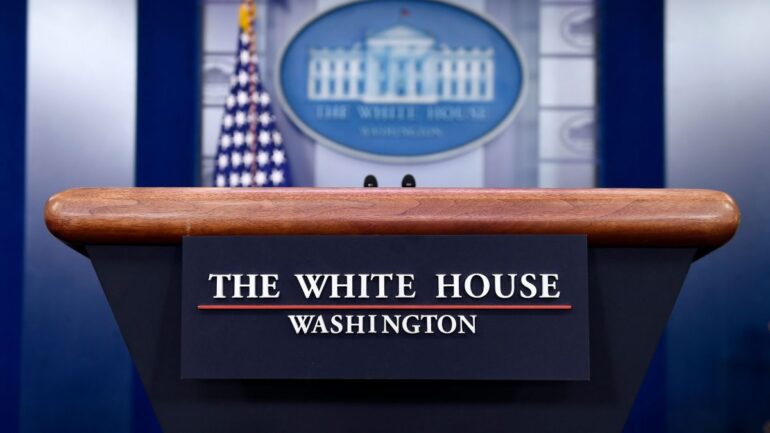TL;DR:
- The White House press shop is facing the challenge of AI-generated deep fakes, requiring swift adaptation.
- Press aides have been briefed on national security risks posed by AI-altered media.
- The White House is scaling up efforts to assess and manage AI risks, emphasizing the responsibility of AI companies.
- The administration updated its strategic plan for AI research and development and initiated the development of an AI bill of rights.
- Uncertainties surround the potential impact of AI, but caution and risk mitigation are essential.
- Prompt debunking of a Pentagon bombing hoax helped the market recover from a momentary dip.
- Another AI-generated deep fake emerged, highlighting the need to stay vigilant as AI technology advances.
- Industry leaders call for global attention to mitigate the risk of AI-induced extinction.
- Proposals for AI regulation and oversight are being considered on Capitol Hill.
- The proliferation of deep fake videos and manipulated images on social media platforms is a growing concern.
- While AI offers significant benefits, the risks, especially during the upcoming presidential election, require careful management.
- The prevalence of AI-generated deep fakes could deepen public mistrust in a democracy.
Main AI News:
The rise of AI-generated deep fakes has presented a significant challenge for the White House press shop. As the dissemination of altered images and videos becomes more frequent, the dedicated team of press aides has had to adapt swiftly to tackle the issue head-on. With the sheer volume of media inquiries they handle daily, the press shop is on the front lines of the battle against AI manipulation.
In response to this emerging threat, the White House has taken steps to address the risks associated with AI. Experts have briefed press aides on the potential national security implications of AI-altered media. Beyond the press shop, the administration has increased efforts to evaluate and manage the risks posed by AI technology. During meetings with AI companies, the White House has emphasized the responsibility of these entities to ensure the safety of their products. As part of this initiative, the administration recently updated its strategic plan for AI research and development, marking the first revision in four years. Additionally, a process has been initiated to develop an AI bill of rights.
Given the uncertainties surrounding AI and its implications, caution is paramount. Prominent tech-focused journalist Kara Swisher points out that even experts are uncertain about the full extent of what may happen. The challenge lies in issuing warnings without making definitive predictions. The administration aims to strike a balance between alerting the public to potential risks while acknowledging the complexity of the situation.
An instance that highlighted the White House’s quick response was the debunking of reports regarding a bombing at the Pentagon. Principal deputy press secretary Olivia Dalton swiftly engaged with the Pentagon and the National Security Council to confirm the absence of any such incident. The administration’s prompt action, accompanied by a supportive tweet from Arlington’s first responders, helped the market recover after a momentary dip of 0.3 percent, equivalent to a staggering $500 billion loss in value for the S&P.
However, the threat persists. Another AI-generated deep fake emerged, this time in the form of a video portraying an alleged Microsoft Teams call between anti-Russia activist Bill Browder and former Ukraine President Petro Poroshenko. In the video, they appeared to advocate for the easing of sanctions against Russian oligarchs. While these fakes were easily identifiable to those familiar with AI, the technology continues to advance rapidly. Soon, AI-generated text, audio, and video could become indistinguishable from human-produced content.
In response to the growing concerns surrounding AI, industry leaders, including OpenAI CEO Sam Altman, issued a stark statement, calling for global attention to mitigate the risk of AI-induced extinction. The statement draws a parallel between AI and other societal-scale risks like pandemics and nuclear war. When questioned about this statement, White House press secretary Karine Jean-Pierre did not explicitly confirm whether the president shares the belief that mismanaged AI could lead to extinction. However, she acknowledged the immense power of AI and emphasized the administration’s commitment to risk mitigation.
Proposals for AI regulation, along with broader oversight of Big Tech, are being deliberated on Capitol Hill. Senator Michael Bennet recently introduced legislation aimed at establishing a federal agency to oversee technology. The White House remains concerned about the proliferation of deep fake videos and manipulated images on social media platforms. As the technology behind creating these falsified media improves, the public and the media need to remain vigilant about this escalating trend.
While the potential benefits of AI are vast and have triggered a global race to harness its capabilities, the unexpected pitfalls could be severe, especially during the upcoming presidential election. It is not the impact of a single piece of content that poses the greatest threat, but rather the cumulative effect of widespread inauthenticity. With AI’s capacity for scaling operations, it becomes possible to create the illusion of massive public support for a particular issue, even when such support does not truly exist. Sarah Kreps, an AI researcher and professor at Cornell University’s Brooks School Tech Policy Institute, warns of the creation of an ecosystem of distrust in a democracy where trust is the bedrock.
Conclusion:
The proliferation of AI-generated deep fakes poses significant challenges for the market. The White House press shop’s adaptive response highlights the need for increased vigilance and regulation to safeguard the integrity of information. This presents opportunities for AI companies to prioritize safety measures and for policymakers to establish regulations that protect against the negative impact of deep fakes. As the market navigates the complexities of AI, ensuring trust and transparency will be crucial in maintaining public confidence.

